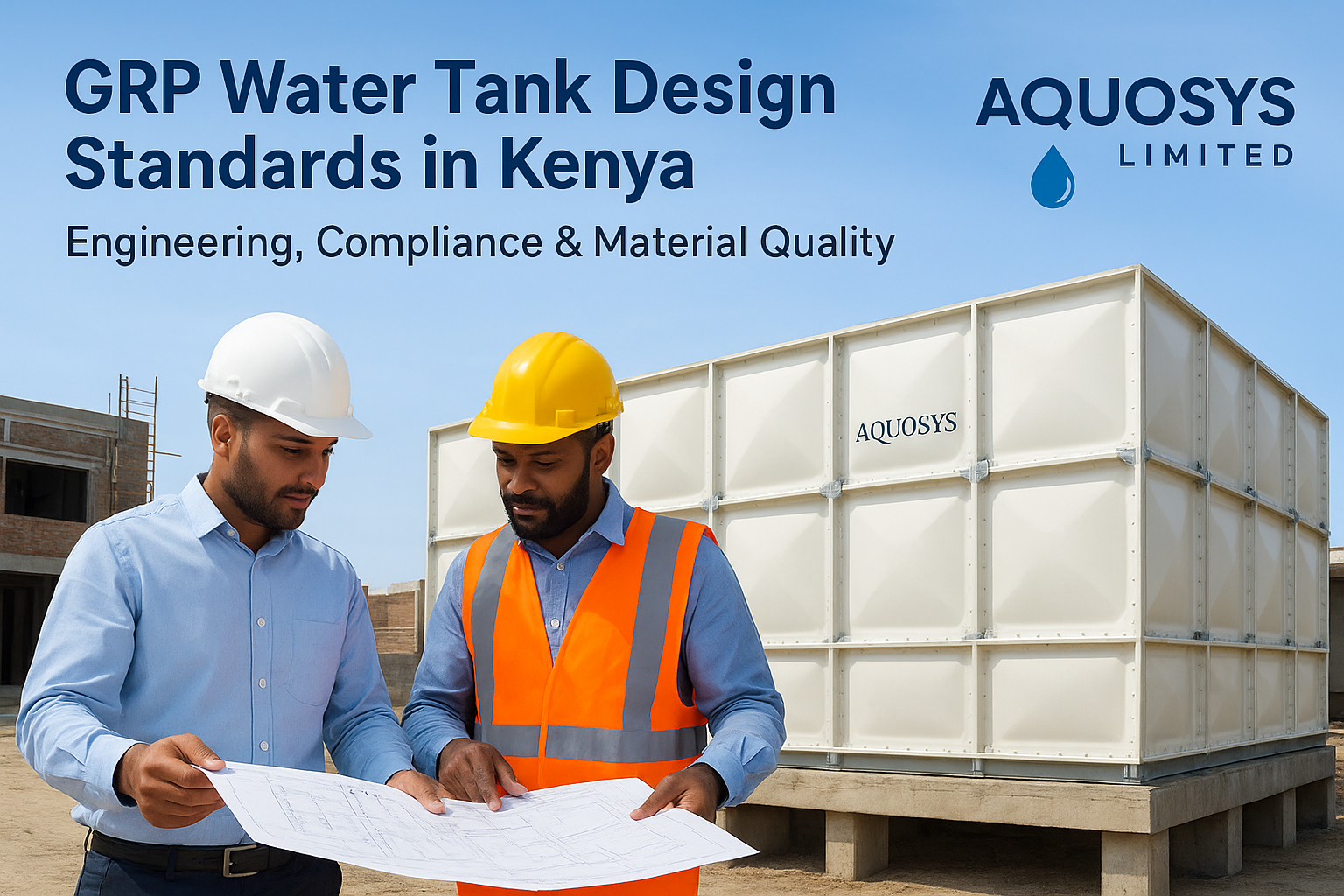GRP Water Tank Design Standards in Kenya

GRP Water Tank Design Standards in Kenya: Engineering, Compliance & Material Quality
🖼 Suggested Featured Image: Engineers reviewing GRP tank design blueprints and structural drawings at a construction site branded with Aquosys Limited.
Introduction: Why Design Standards Matter for GRP Water Tanks
Every GRP (Glass Reinforced Plastic) water tank begins as a precise engineering design. The structural safety, water tightness, and durability of the tank depend on adherence to strict international standards. In Kenya, where environmental conditions vary from humid coastlines to arid regions, the design process must account for temperature changes, UV exposure, seismic stability, and water chemistry.
Aquosys Limited follows globally recognized standards such as BS EN 13280, ISO 9001, and WRAS (UK) to ensure each GRP sectional water tank is built for long-term reliability, safety, and compliance with both local and regional building codes.
In this article, we’ll explore key GRP design standards, structural parameters, and quality control processes applied in professional water storage solutions across East Africa.
1. Key International GRP Tank Design Standards
GRP tank design draws from several engineering frameworks that define the strength, stiffness, and safety factors of the material and structure. The most widely adopted include:
- BS EN 13280: European standard for the design and manufacture of GRP sectional water storage tanks.
- BS 7491: Code of practice for design of reinforced plastic tanks and vessels.
- ISO 9001:2015: Quality management system standard ensuring consistent production quality and traceability.
- WRAS Approval (UK): Ensures that tank materials are safe for potable (drinking) water applications.
- KEBS Certification (Kenya Bureau of Standards): Local compliance confirming adherence to Kenyan and East African water safety requirements.
At Aquosys Limited, every GRP panel and fitting undergoes testing for tensile strength, deflection limits, and leak-proof integrity according to these standards.
2. Material Composition and Strength Requirements
The structural integrity of a GRP tank relies on the balance between fiberglass reinforcement and resin matrix. Aquosys employs isophthalic and orthophthalic resins for chemical resistance and high mechanical strength.
Typical design parameters:
- Panel thickness: 5–12 mm depending on tank capacity and pressure rating
- Tensile strength: Minimum 70 MPa
- Flexural strength: 150 MPa or greater
- Thermal stability: Up to 120°C continuous operation
- UV resistance: UV-stabilized gelcoat for outdoor installations
Each panel’s composite structure is analyzed using finite element modeling (FEM) to predict performance under hydrostatic pressure and temperature variation.
3. Structural Design and Load Calculations
GRP water tanks must withstand both static and dynamic loads, including water pressure, wind uplift, and seismic activity. Aquosys engineers perform detailed design calculations to ensure the tank maintains shape and stability under all conditions.
Structural considerations include:
- Internal water pressure on side walls and base panels
- Roof load from access platforms or maintenance personnel
- Thermal expansion and contraction
- Anchoring and support on elevated structures
All calculations follow the BS EN 13280 structural design code to ensure safe performance across varying capacities — from 10,000L domestic tanks to 1,000,000L municipal reservoirs.
4. Hygienic and Potable Water Standards
For potable water applications, internal surfaces of GRP tanks must meet hygiene standards that prevent bacterial growth and contamination. Aquosys applies a smooth, non-toxic, food-grade gelcoat to all water-contact surfaces, ensuring compliance with:
- WRAS (Water Regulations Advisory Scheme)
- WHO guidelines for potable water storage
- KEBS potable water safety specifications
The inner lining resists scaling, corrosion, and algae growth — critical for municipal, hospital, and school water systems.
5. Quality Control and Testing Procedures
Before delivery and installation, Aquosys Limited subjects each GRP panel and tank assembly to comprehensive quality control checks:
- Hydrostatic leak tests (24–48 hours water retention)
- Dimensional and alignment verification
- Gelcoat hardness and adhesion testing
- UV exposure and impact resistance tests
Testing records are documented in compliance with ISO 9001 and made available to clients upon project completion.
6. Custom Design and Engineering Support
Every project site is unique — from rooftop installations in Nairobi to ground-level systems in Mombasa or Eldoret. Aquosys engineers customize GRP tank designs based on load factors, layout, and space availability.
- 3D CAD modeling and finite element simulations
- Custom reinforcement and tie-rod layouts
- Integration with existing plumbing and pump systems
- Documentation and compliance certification
Clients receive detailed drawings and technical support throughout design, fabrication, and installation phases.
Why Choose Aquosys Limited for GRP Design & Manufacturing
With a legacy of engineering excellence, Aquosys Limited is Kenya’s trusted source for certified GRP water storage systems. Our in-house team ensures every tank design meets international performance benchmarks and local site conditions.
- Certified materials and WRAS-approved resins
- BS EN 13280-compliant design calculations
- KEBS-approved fabrication processes
- End-to-end design, testing, and installation support
Explore our Portfolio and Gallery for completed GRP tank designs across East Africa.
Need Expert GRP Tank Design Services in Kenya?
Partner with Aquosys Limited — the engineering experts in GRP tank design, manufacturing, and installation across Kenya and the greater East African region.
📞 Contact Aquosys Limited
✔ Certified engineering design and installation
✔ Custom GRP tank fabrication
✔ Full compliance with international standards
Email: sales@aquosys.co.ke
Phone: +254 754 750 750 | +254 729 749 749
Website: Get in Touch


